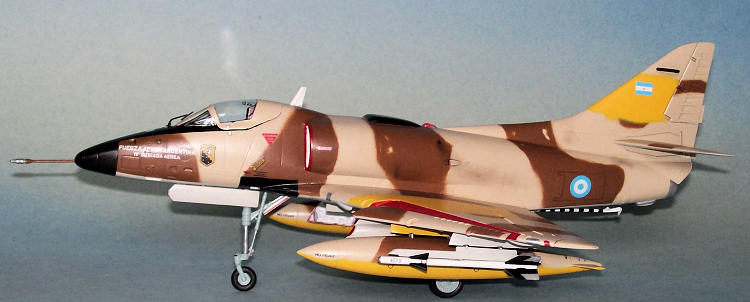
Hobbycraft 1/48 A-4C Skyhawk C-313
| KIT #: | HC 1434 |
| PRICE: | CDN$30.00 MSRP |
| DECALS: | Two options |
| REVIEWER: | Pablo Calcaterra |
| NOTES: | Aerocalcas # 48011 decals used |

| HISTORY |
After the successful introduction of the
Scooter (A4-B modified to A4-P standard, but called nevertheless A4-B by the
Argentine pilots) in late 60s, the Air Force decided to buy more 25 Skyhawks,
this time of the C model. The idea was to replace the F-86 Sabres in service in
El Plumerillo,
During the 1978 crisis with 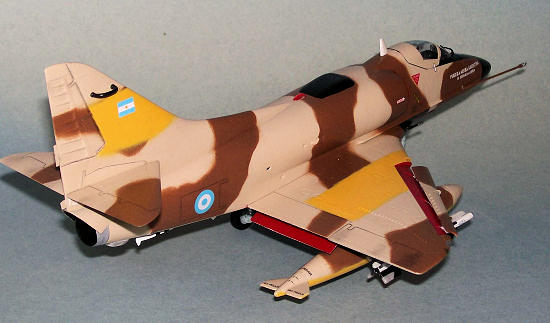 two of those missions in 1978.
two of those missions in 1978.
In 1982, after the actions of April 2nd
and when it became clear that the British Task Force was on its way to retake
the islands, the 1st Squadron was sent to
After the first actions on May 1st,
the Argentine Air Force South (Fuerza Aerea Sur -FAS), led by Ernesto Crespo,
decided to counter attack the ships in the area around the islands. In order to
improve the chances of success, several CAPs were sent, along with several
missions flying low to attack the ships. The CAPs were supposed to saturate and
attract the British CAPs, in order to free the low flying attack planes
(Daggers, Canberras and Skyhawks).
It’s a not very well known fact that there were
CAPs flown that day by the A4-Cs. For these, they used as armament their Shafrir
missiles (roughly equivalent to the Sidewinder B). Again, it was well understood
that they had little chances against the better-armed and more maneuverable
Harriers, but the idea was to saturate the British defenses.
OF 1103: Lt. Jose Vazquez (C-313) and Capt.
Atilio Zattara (C-304), call sign
OF unknown: Lt Nestor Lopez (C-303) and Lt.
Daniel Manzotti (C-310)
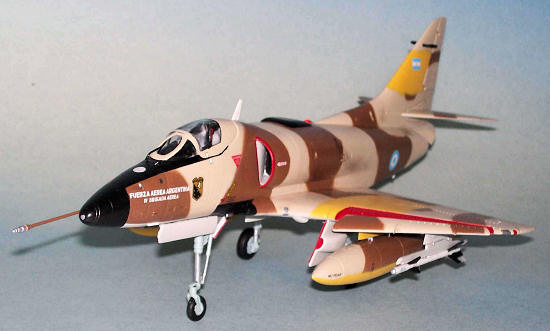 OF 1106: Capt. Eduardo Almono (C-322) and Ensg
Carlos Codrington (C-325), call sign
OF 1106: Capt. Eduardo Almono (C-322) and Ensg
Carlos Codrington (C-325), call sign
May 9th:
The Argentine radar in Puerto Argentino/
OF 1174: Four A4-C, call sign TRUENO. One
British bomb of 1,000 lb each plane, led by Capt. Jorge Garcia, his wingmen
being Lt Jorge Farias, Lt Jorge Casco, Ensign Gerardo Isaac. They took off from
San Julian. When trying to refuel from the KC-130 tanker, Trueno 1 and 4 had
problems so they turned back. Trueno 2 and 3 kept on flying, as their refueling
was successful. Meanwhile, other missions were aborting due to the solid cloud
cover that was not allowing them to see the surface of the sea. Now Casco took
the lead, followed by Farias. They descended into the clouds, looking for their
targets. In such conditions, they should have returned to base but they were too
eager to press the attack. They flew under the clouds, into showers and fog.
They asked for an update of the position of the ships (“Where are those d…
ships!”) and they were answered that they were farther East. So they
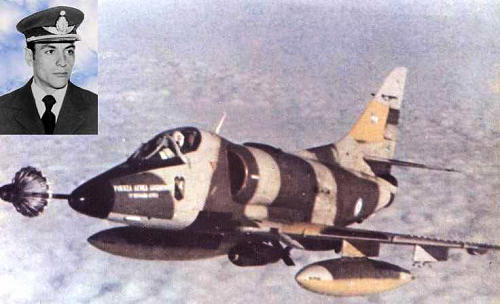 kept on
going. But the problem is that they had descended too early and without knowing
it, they were in the area of the Salvajes / South Jason Is. On top of this, the
radar in the islands was not able to see them as they were still too far to the
West, flying too low. With very bad visibility, Casco flew his plane into a
cliff on the West side of South Jason / Sebaldes island. Though Farias plane has
not been positively found, there are indications that it might have crashed in
shallow water to the southwest of Casco’s last position. In 1982, after the war
ended, C-313 was found with the pilot still inside the cockpit. The plane had no
trace of missile impact. In fact, the island and the cliff were between Casco
and HMS
kept on
going. But the problem is that they had descended too early and without knowing
it, they were in the area of the Salvajes / South Jason Is. On top of this, the
radar in the islands was not able to see them as they were still too far to the
West, flying too low. With very bad visibility, Casco flew his plane into a
cliff on the West side of South Jason / Sebaldes island. Though Farias plane has
not been positively found, there are indications that it might have crashed in
shallow water to the southwest of Casco’s last position. In 1982, after the war
ended, C-313 was found with the pilot still inside the cockpit. The plane had no
trace of missile impact. In fact, the island and the cliff were between Casco
and HMS
While a British team was trying to defuse the
bomb in 2001, a fire burnt the Southern tip of the island, creating a disaster
as 90% of the native Tussac Grass was lost and thousand of penguins and other
birds perished. It took at least 5 days to control the fire.
Lt. Jorge Casco is now buried in the Argentine
Cemetery in Darwin, Soledad/East
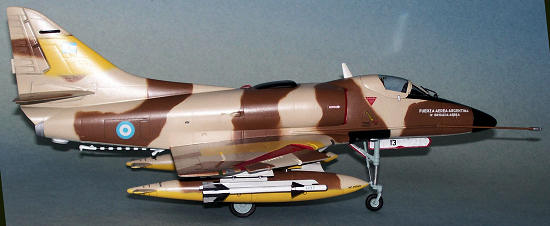 What happened to the other pilots mentioned
above?
What happened to the other pilots mentioned
above?
Vasquez:
shot down and killed during the last seconds of the mission to attack to HMS
Invincible on May 30th, mission to which he volunteered.
Zattara:
survived
Lopez and Manzotti:
shot down and killed together in the same mission by Sea Harriers on May 21st.
Almono and Codrington:
survived the war
Garcia:
shot down by HMS Coventry on May 25th while climbing to eject as his
plane had been badly damaged during an attack to the beachhead in
Isaac:
survived the war
| THE KIT |
No information provided, but there are previews of various
Hobbycraft Skyhawks in the archives. Ed.
| CONSTRUCTION |
The Hobbycraft kit is pretty good. It makes a
very accurate Skyhawk C. There are some minor details missing but more about
that below.
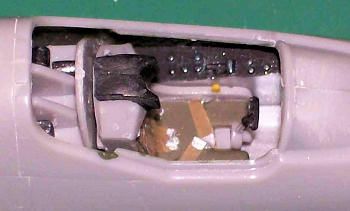 Cockpit:
the parts go together very easy. I only added some photoetched seat belts from
the spares box. The dials were given some drops of Future. A very light dry
brush with silver highlighted some buttons and controls in the cockpit. Weight
was added inside the nose in the form of nuts and bolts (aprox. 10 grams)
Cockpit:
the parts go together very easy. I only added some photoetched seat belts from
the spares box. The dials were given some drops of Future. A very light dry
brush with silver highlighted some buttons and controls in the cockpit. Weight
was added inside the nose in the form of nuts and bolts (aprox. 10 grams)
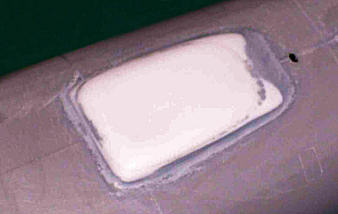 Fuselage:
The halves were put together, with some putty and sanding here and there to have
a smooth joint. The dorsal Radome supplied by HC has the wrong profile and was
discarded so with a couple of layers of plasticard I scratchbuilt a new one.
Putty was used to have a nice union to the fuselage. There is also a little
intake at the front of the tail that needs to be covered with Putty. Another
addition was the APX6 radome under the tail, which I made in resin. I
Fuselage:
The halves were put together, with some putty and sanding here and there to have
a smooth joint. The dorsal Radome supplied by HC has the wrong profile and was
discarded so with a couple of layers of plasticard I scratchbuilt a new one.
Putty was used to have a nice union to the fuselage. There is also a little
intake at the front of the tail that needs to be covered with Putty. Another
addition was the APX6 radome under the tail, which I made in resin. I
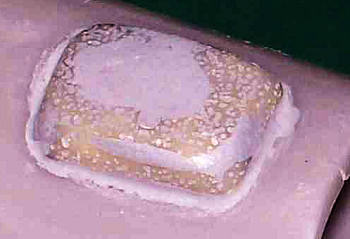 have built
so many Skyhawks and have so many more to build that I made a mold in rubber
and just make copies over and over again when needed. In this case, I had to use
a considerable amount of putty to get a better surface and a nice smooth union
with the fuselage. As part of the preparation for later stages, I painted the
interior of the air intake in white (both in the fuselage
have built
so many Skyhawks and have so many more to build that I made a mold in rubber
and just make copies over and over again when needed. In this case, I had to use
a considerable amount of putty to get a better surface and a nice smooth union
with the fuselage. As part of the preparation for later stages, I painted the
interior of the air intake in white (both in the fuselage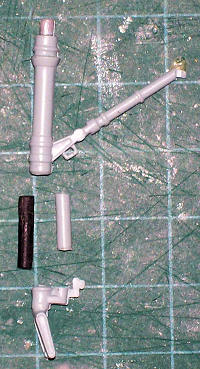 and the walls of the
intake). Then the end of the intake was painted with a brush in black. With the
paint dry, I glued the intakes in place.
and the walls of the
intake). Then the end of the intake was painted with a brush in black. With the
paint dry, I glued the intakes in place.
Rest of the plane:
Everything went very fast from this point onwards; construction being very easy
and no more fixes worth mentioning took place. The nose wheel oleo is too short
as the Cs had kind of a nose up attitude while on the ground. I cut out the
central part of the nose landing gear and replaced it with a longer one. All the
landing gear (nose and main) was given a coat of gloss white.
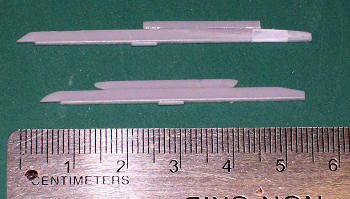 Armament:
There are two types of missiles in the kit. One is fairly similar to the Shafrir/Sidewinder.
The only difference is the moveable front surfaces, which are wrong. They need
to be triangular. So some cutting fixed this issue. I painted the body of the
missile in gloss white and then masked it to give it the black coat to all the
fins (large ones with gray areas in the back, triangular on the front). The
rails for the missiles are not correct for an Argentine plane. In this picture
you can see some of the modifications in terms of length and profile that took
place.
Armament:
There are two types of missiles in the kit. One is fairly similar to the Shafrir/Sidewinder.
The only difference is the moveable front surfaces, which are wrong. They need
to be triangular. So some cutting fixed this issue. I painted the body of the
missile in gloss white and then masked it to give it the black coat to all the
fins (large ones with gray areas in the back, triangular on the front). The
rails for the missiles are not correct for an Argentine plane. In this picture
you can see some of the modifications in terms of length and profile that took
place.
| COLORS AND MARKINGS |
The wheel wells were painted in white and
masked. The undersides were painted in light gray (MM Acryl 4766), followed by
the topsides with Sand (MM Acryl 4720). I then used BluTac to make the soft
demarcation marks for the brown (MM Acryl 4707…but now I think that I should
have used a less reddish brown like 4709…too late for me but take my advice if
you are planning on making this colour scheme). The picture of the plane in
flight during the last mission and some others of the plane earlier in her life
helped me to place the demarcation lines correctly. Well, not so correctly at
first. The brown on the left side of the nose had to
 be re done 3 times as it
was first too low, then I redid it and now it was too far back. Finally, third
is the charm, I got it right but not before having painted the black in front of
the windshield and nose tip, which helped me to get it finally right. Also black
for the dorsal Radome and area around the guns.
be re done 3 times as it
was first too low, then I redid it and now it was too far back. Finally, third
is the charm, I got it right but not before having painted the black in front of
the windshield and nose tip, which helped me to get it finally right. Also black
for the dorsal Radome and area around the guns.
Next came the red for the interior of the
slats, flaps and the lip of the air intakes (after a very careful masking
process). And finally the yellow ID bands that in this case also had a soft edge
(compared, for instance, to the hard edge applied to the Skyhawks B). More
BluTac.
The same light gray of the undersides was used
for the front half of the white VHF antenna.
RLM 65 was used for the landing gear.
Some worn areas of the brown paint (tail and
fuselage) were created by carefully sanding off the paint (exposing the sand
base colour) with 1200 wet sandpaper. With a very sharp pencil I highlighted the
moveable parts and some exhausts and little intakes.
 I dirtied the plane with a brush and sanded
black pastel (moveable surfaces, exhausts on the fuselage, ejection chutes)
I dirtied the plane with a brush and sanded
black pastel (moveable surfaces, exhausts on the fuselage, ejection chutes)
| FINAL BITS |
I glued the landing gear, VHF antenna,
refueling probe, missiles (with the new shaped forward fins, some decals for the
red bands and a silver nose), exhaust (in black and aluminum), pitot tube,
arrestor hook in black and white, landing gear doors and drop tanks.
Other small painted details include:
I scratch built the following items:
| CONCLUSIONS |
As you can see, you can fairly easy make an accurate A4-C of the Argentine Air Force in 1982. I am very happy with the result…except for the brown as I mentioned above. Hope you have enjoyed this very short but quite unknown story of the Air-to-Air role of the Scooter during the South Atlantic War.
| REFERENCES |
Falklands Air War – Hobson
Air War in the Falklands – C. Chant (Osprey)
Historia Oficial de la Fuerza Aerea Argentina –
Volume 6
A4-C Skyhawk – Nunez Padin 2008
A4-B y C Skyhawk – Nunez Padin 1997
A4-B/C – Fernando Benedetto. It has a very
interesting picture of a line of Cs where it can clearly be seen that two color
schemes coexisted: gray and green, and brown and sand.
Four weeks in May – Hart Dyke (Captain of HMS
Coventry)
One Hundred Days – Sandy Woodward (also says
that the missiles shot on the 9th did not hit the planes and does not
mention the Skyhawks of Casco and Farias)
Pablo Carballo, for his constant support and
his permission to use the last picture of Casco’s C-313 refueling in flight
during the fateful mission on May 9th.
Allan White, for his information about the fire
on the island caused by the team trying to defuse the bomb and details about
Garcia’s finding.
Fernando Benedetto, for the pictures that show
that there were actually 2 different colour schemes
January 2010
If you would like your product reviewed fairly and quickly, please contact me or see other details in the Note to Contributors.